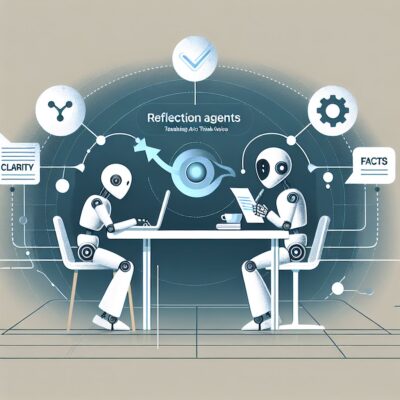A Deep Dive into How AI Can Learn From Its Own Mistakes—In Real-Time
AI agents have become increasingly capable: they write, summarize, code, search, and even coordinate tasks. But most still suffer from a major limitation: they don’t learn from their own mistakes—at least not immediately.

That’s where Reflection Agents come in.
Inspired by human reasoning and self-evaluation, Reflection Agents are designed to critique, revise, and improve their own outputs before finalizing them. It’s one of the most promising patterns in modern AI—and may be the key to scaling autonomous agents in complex real-world environments.
In this article, we’ll break down:
-
What reflection agents are
-
How they work
-
Why they matter
-
Where they’re already being used
-
How to build one yourself
-
What’s next
What Is a Reflection Agent?
A Reflection Agent is an AI system that:
-
Performs a task (like summarizing, solving, or writing)
-
Critically evaluates its own output
-
Improves or revises the output based on feedback or introspection
The key idea? Self-critique followed by self-improvement.
Unlike typical LLM-based apps that “generate and forget,” reflection agents loop through a Think → Do → Evaluate → Improve cycle, much like a human editing their own essay or debugging their code.
Why Reflection Matters in AI Systems
LLMs (like GPT-4, Claude, or Mistral) are incredibly capable—but they’re not flawless:
-
They hallucinate facts
-
They generate code with bugs
-
They misunderstand intent
-
They often lack error-checking or contextual awareness
Reflection addresses these problems by:
-
Catching factual errors
-
Improving coherence
-
Reducing hallucination
-
Re-aligning with the user’s goal
And best of all: it happens within the agent itself, not from external validation.
How Reflection Agents Work: The Core Loop
A typical reflection agent follows this loop:
1. Initial Task Execution
The agent performs a task (e.g., answering a question, generating a response, solving a problem).
2. Self-Critique or Feedback Collection
The agent either:
-
Critiques its own output using a second LLM pass (“Let’s review my answer”)
-
Gets feedback from another agent (multi-agent reflection)
-
Or uses predefined criteria (“Does this meet the instructions?”)
3. Reflection
The agent identifies flaws, gaps, or areas for improvement.
4. Revision or Retry
The agent improves the answer, either:
-
Modifying directly
-
Or redoing from scratch using the new insight
Example: Reflection in Action
Prompt:
Write a short blog post introduction about climate change.
Agent Output (Initial Draft):
Climate change is a big problem. It affects the world and many people. We must act fast.
Critique (Reflection Step):
The response is vague and lacks specific data or a hook to engage readers. Let’s improve clarity and add a fact.
Revised Output:
Climate change is accelerating at an unprecedented rate, with 2023 ranking as the hottest year on record. From rising sea levels to intensifying wildfires, the impact is global—and urgent action is needed.
Clearer, more informative, and impactful.
How to Build a Reflection Agent
You can build one using tools like:
🔹 LangChain + LangGraph
-
Use LangGraph to define the loop: Task → Critique → Improve → Finalize
-
Use LangChain’s
LLMChainwith memory to track evaluations
🔹 AutoGen
-
Set up a “critic agent” to review and provide feedback to a “worker agent”
-
Integrate iterative turns until confidence is high
🔹 OpenAI Function Calling
-
Use structured reflection prompts like:
Task: Summarize
Output: [response]
Reflect: Did this meet the criteria of clarity, completeness, and tone?
🔹 Prompt Pattern
Reflection = Better results with minimal extra cost.
Real-World Use Cases
Business
-
Sales copy that self-tunes for tone and clarity
-
Emails that check for alignment and politeness
DevTools
-
Code generators that identify and fix their own bugs
Education
-
AI tutors that review answers before giving them
-
Adaptive learning assistants that re-explain concepts if misunderstood
Research
-
AI systems generating hypotheses and refining them via critique
Challenges in Reflection
Reflection isn’t magic. It comes with trade-offs:
Time & Cost
Every reflection loop adds tokens and latency. For high-speed apps, it may not be practical.
Memory Management
Agents need to remember what they said and how they revised it. Poor memory = poor reflection.
Overconfidence
Sometimes models falsely believe their initial answer is correct. Self-critique must be carefully prompted.
Infinite Loops
Without limits, agents can get stuck in “reflection paralysis.” Add a maximum number of retries.
Why Reflection Agents Are the Future
Reflection is a foundational pattern in agentic AI. As agents become more autonomous, they’ll need to:
-
Adjust to real-world environments
-
Learn from outcomes
-
Collaborate with other agents
-
Optimize for goals over time
Reflection is the bridge between one-shot generation and autonomous behavior.
In the future, we’ll see:
-
Agents that learn across sessions
-
Reflective systems that reason about risk, ethics, and bias
-
Fully adaptive LLM-powered products that evolve with user feedback




